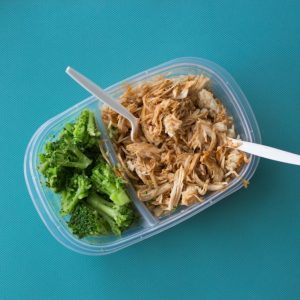 Giving children a strong nutritional start supports healthy development and prepares them to make healthful choices later in life. As a teacher, I get a first hand look at children’s lunches. In my observation, modern lunches are commonly high in refined, high glycemic carbohydrates, and low in good quality fats and protein, fibrous foods, and essential vitamins and minerals. Most high glycemic foods, such as bread, commercial cereal, and processed baked goods, offer minimal nutritional value and are quickly converted to sugar. This leads to rapid spikes and drops in blood sugar levels. For adults, low blood sugar often results in the “foggy,” sluggish feeling that sends us reaching for a coffee mid-afternoon. Conversely, when children experience blood sugar swings, they often present with hyperactivity, aggressive behaviours, and difficulty concentrating, playing cooperatively, and regulating emotions. School lunches and snacks should provide them with the essential nutrients they need for healthy development and learning.
Giving children a strong nutritional start supports healthy development and prepares them to make healthful choices later in life. As a teacher, I get a first hand look at children’s lunches. In my observation, modern lunches are commonly high in refined, high glycemic carbohydrates, and low in good quality fats and protein, fibrous foods, and essential vitamins and minerals. Most high glycemic foods, such as bread, commercial cereal, and processed baked goods, offer minimal nutritional value and are quickly converted to sugar. This leads to rapid spikes and drops in blood sugar levels. For adults, low blood sugar often results in the “foggy,” sluggish feeling that sends us reaching for a coffee mid-afternoon. Conversely, when children experience blood sugar swings, they often present with hyperactivity, aggressive behaviours, and difficulty concentrating, playing cooperatively, and regulating emotions. School lunches and snacks should provide them with the essential nutrients they need for healthy development and learning.
Canadians teens aged 14-18 consume the largest amount of sugar across all age groups at 170 grams per day, nearly 1 cup. Among Canadian children aged 1-8, the main source of sugar comes from milk and juice; and for children aged 9 to 18, milk and pop. Replacing a juice box or milk carton with water, can reduce sugar intake by 30 grams per day. While many kids drink milk daily for its calcium content; broccoli, almonds, almond milk, and legumes are great non-dairy sources. Children need regular snacks throughout the school day to help them focus and learn. Understandably, packing a lunch to meet your child’s taste preferences and at the same time avoid allergenic foods can be an arduous task. Try fruit and plain yogurt, veggies and hummus,or a homemade muffin as nutritious alternatives.
A main concern with packaged children’s snack foods is the synthetic dyes found in many products. Commonly derived from petroleum byproducts, dyes are added to food items to make them visually appealing. Many of the synthetic food dyes lurking in your children’s foods, have been linked to cancer, allergic reactions and behavioural concerns, among a list of other adverse effects. Food dyes are not only troublesome for children with ADHD and other autism spectrum disorders; they can cause behavioural changes in children who don’t normally present with these symptoms. Interestingly, the European Union requires a warning label on products containing food dyes and has banned the use of several dyes, which continue to lurk ;on our grocery store shelves. Watch out for food dyes in baked goods, cereals, sport drinks, yogurt, candy, gummy snacks, and granola bars.
Children require good quality fats for brain and nervous system development, and to help absorb fat-soluble vitamins. Nuts, seeds, avocado, and oils are some of the best sources. Due to food allergies, breakfast and after school snacks are an ideal time to get some of these foods into your child’s diet. Quick cooking oats with maple syrup, chopped almonds, and a teaspoon of coconut oil, provides them with slow digesting carbohydrates, protein, fiber, healthy fat, and B vitamins.
Involve children in grocery shopping and meal preparation so they too can learn how to fuel their bodies for optimal health.
By Daniell Goobie, RHN. Danielle is a Registered Nutritionist at Body Design. Body Design offers personal training, yoga and group fitness classes and nutrition coaching to assist individuals achieve their fitness and weight loss goals.